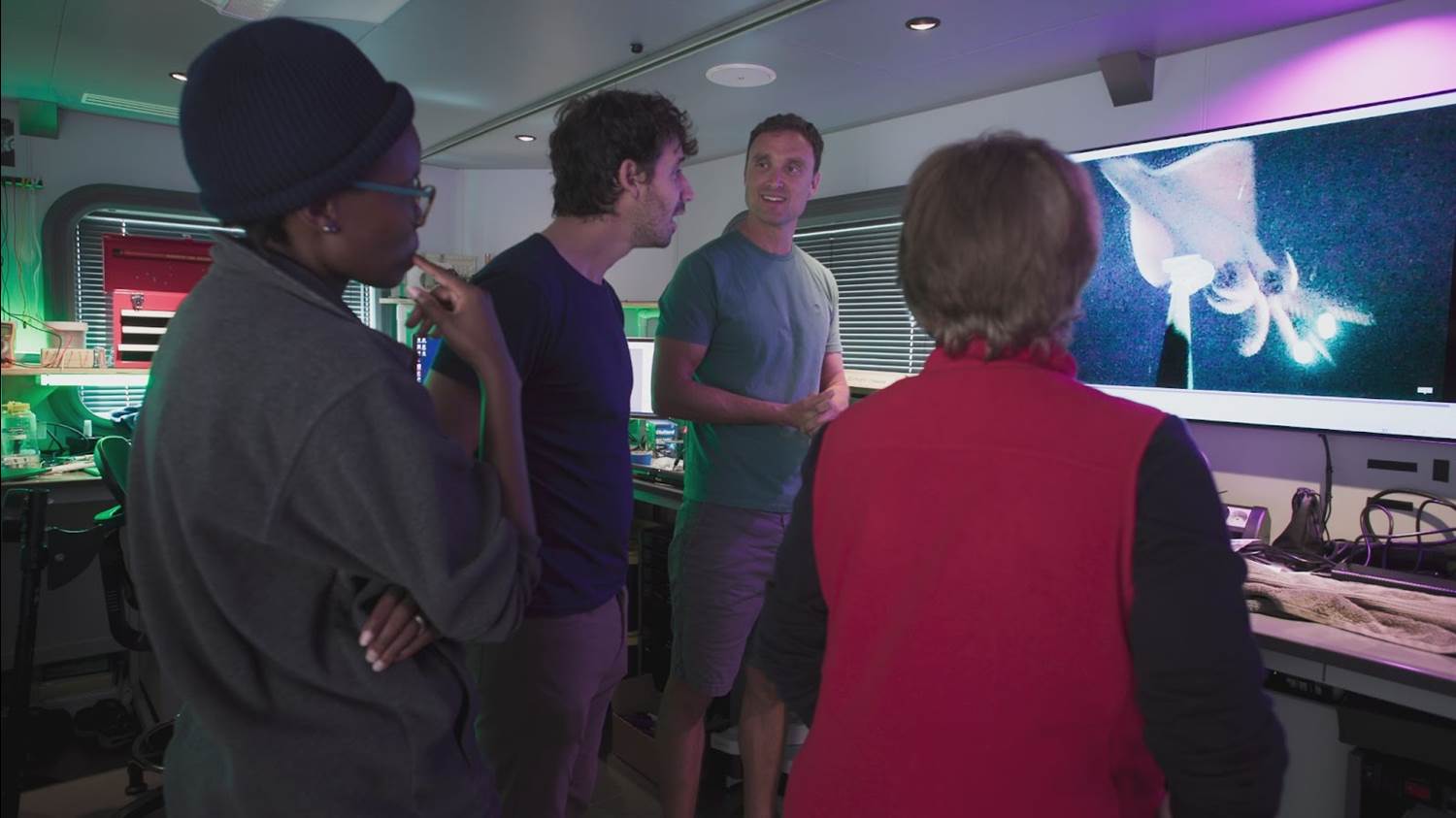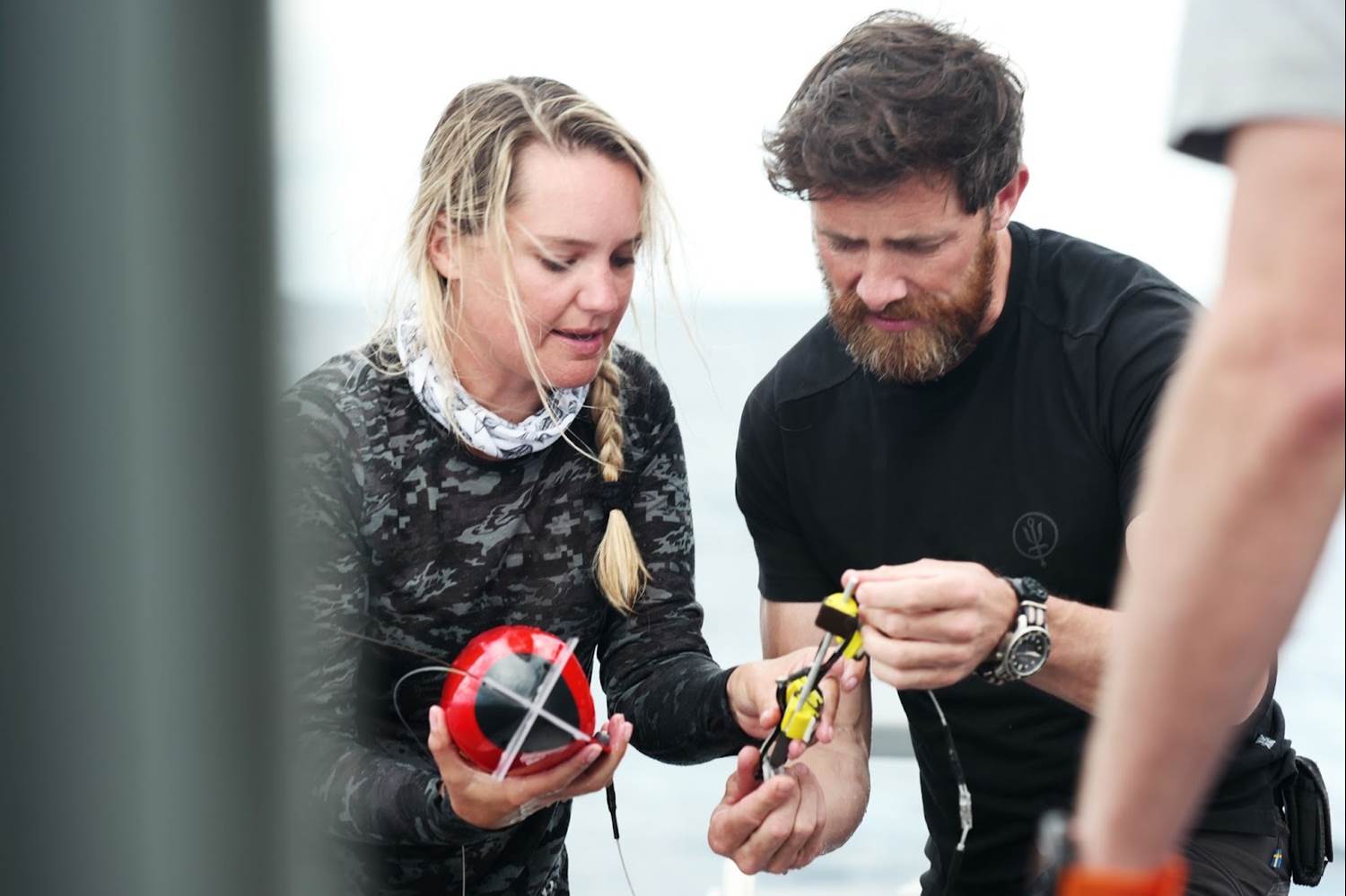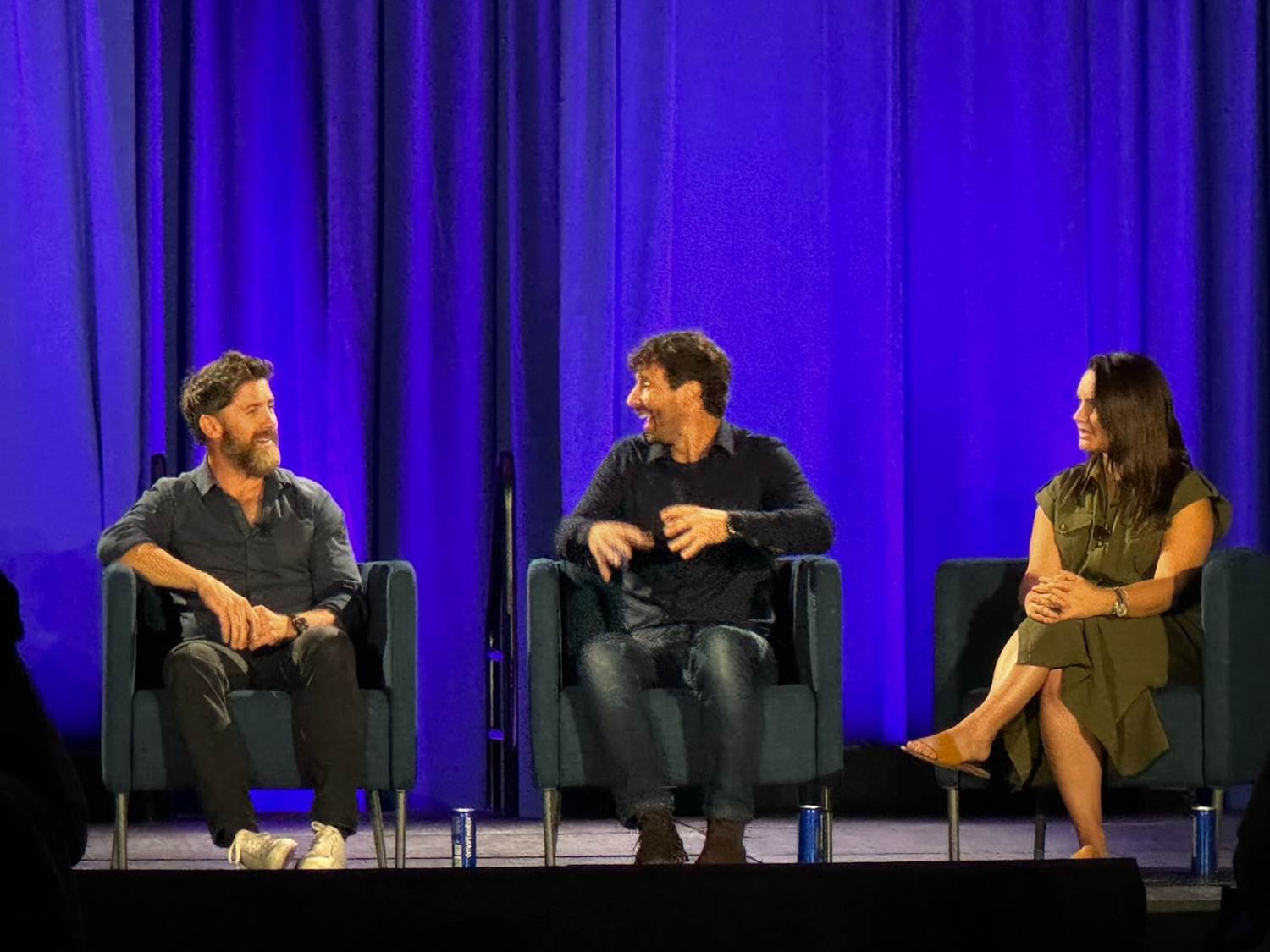Epic, Wonder, Momentum: Behind the Scenes of Nat Geo’s “OceanXplorers”
National Geographic’s OceanXplorers premieres Sunday, August 18th, at 9/8c on Nat Geo and begins streaming on Disney+ and Hulu on Monday, August 19th. Ahead of the series premiere, I got to speak with team members Eric Stackpole (Ocean Technology Innovator) and Aldo Kane (Ex-Royal Marine, Special Ops). The duo also attended D23: The Ultimate Disney Fan Event on August 11th, giving attendees an early look at the series. At D23, Eric and Aldo were joined by featured participant Erin Spencer (Nat Geo Explorer and Marine Ecologist) in a panel moderated by Malaika Vaz (National Geographic Explorer and Filmmaker). When Malaika asked the panelists to describe OceanXplorers in one word, Aldo said “Epic," Eric said “Wonder," and Erin said “Momentum."
The D23 panel kicked off with each explorer sharing how they found their way into the world of exploration. Aldo Kane, who has always had a "thirst and quest for adventure," described how his journey began in his youth and culminated in joining the military. Eric Stackpole, who originally started in space exploration, shifted his focus to the ocean after realizing it was "this vast unknown area, teeming with life we've never seen," and a place where you "don’t need a rocket ship to get there." Erin Spencer, on the other hand, shared a more serendipitous path. Initially working as an intern in Nat Geo’s travel department, she was inspired by the explorers she met, leading her to change her major and eventually become a marine scientist. "It’s all really because of that first job I had at Nat Geo," she remarked.
How did Eric Stackpole and Aldo Kane come to be involved with OceanXplorers? That’s a question I had for them during our interview. “I've been building underwater exploration tools for more than a decade," Eric explained, the founder of OpenROV, an open-source remotely operated vehicle company. “I met some of the producers for the show, Maria Wilhelm and James Cameron. They were really into this sort of technology that allows us to give access to exploration to everyone. As that relationship grew and the show started to come around, they suggested I try out for it. It changed my life." Aldo Kane had a similar experience, working on a BBC documentary called Tigers: Hunting the Traffickers when another member of the crew told him about James Cameron’s passion project and suggested he throw his name in the hat.
“The funny part of it was we all ended up in L.A. doing escape rooms and all sorts of tests," Aldo Kane shared about the audition process to join the team on OceanXplorers. “You had some of the best people in the world in one area, all going through the process to see who would be the four people on these missions and bringing this to the world." This was around five years ago, with a global pandemic throwing a curveball at the project. “We thought we would just start filming right away," Eric added, revealing that the footage featured in the series was shot across three two-month voyages in late 2020 and 2021. “It’s been in post-production for a long time as they get all this incredible footage put together in a way to tell the story. So for us, it’s been nearly half a decade in the making."

(National Geographic)
During the D23 panel, Eric Stackpole gushed about the technology onboard the OceanX vessel featured in the series, having had a hand in developing some of the technology used on the ship. He described it as "the pinnacle of ocean exploration technology," equipped with everything from crewed submersibles that can dive over 3,000 feet to a deep-sea ROV capable of reaching depths of 20,000 feet. The ship’s ability to deploy all its assets overnight was another point of pride. "We can have the helicopter up, we can have two submersibles in the water, I can be diving off one of the dive vessels, we can have the ROV down, we could be doing CTD measurements—all at once," Aldo Kane explained, highlighting the operational efficiency of the ship.
While the core OceanXplorers team consists of Eric Stacpool, Aldo Kane, Zoleka Filander (National Geographic Explorer and Deep-Sea Researcher), and Melissa Cristina Márquez (Shark Biologist), each episode invites field experts aboard to carry out their own expeditions. “You have a scientist or a couple of scientists whose entire life work, their PhD, is based around this animal, and their research is cutting-edge in that field," Aldo Kane told me. “To hand that over to the four of us, the ship, and television is quite a big ask. Trust was a huge part of it, and that comes from the top. Knowing that you have James Cameron and his team, knowing that you have BBC Studios and their team, and knowing that it’s for National Geographic, it doesn’t get any bigger or better than that."
That’s where Erin Spencer’s participation in the D23 panel came in handy, sharing her perspective on boarding this state-of-the-art vessel and working with this team of experts to conduct her research. “I was there to talk about hammerheads," Erin told D23 attendees about her trip to Florida and the Bahamas. “To work on these sharks, it takes such a huge team to begin with, just from a safety perspective and the shark handling perspective, but then also to have fresh perspectives. For example, Eric and I sat down looking at the tag, and I was having some issues with part of the design and how to store some of these materials. Over the course of a casual afternoon chat, I came away with so many fresh ideas of how we could solve this problem, which is something that I never would have had the opportunity to do otherwise." Also new to Erin was the ability to have multiple teams with different skills working at the same time to get the full picture. “While we’re [tagging hammerheads], someone’s in the air in the helicopter, someone is diving, all these simultaneous operations are happening. I’ve been on a number of different types of vessels, and that’s just not common. It’s truly remarkable how much was able to be accomplished in such a short amount of time because of that collaboration."

(National Geographic/Mario Tadinac)
OceanXplorers follows this incredible team on missions to study wildlife that depends on the health of the oceans for their survival, including polar bears and several species of whales and sharks. “There’s actually so much that we don’t know about [hammerheads] fundamental biology and ecology because they’re really difficult to study," Erin Spencer shared about the well-known shark species she’s devoted years of her life to studying. “We have this biologging technology, which is essentially just like an Apple Watch, but you put it on a shark, and they can swim around and collect the data for us. When you see us deploying these tags, which have all of these sensors of speed and acceleration, we can do all these amazing calculations. For example, I calculated how many calories a great hammerhead shark needs to eat in a day, what kind of temperatures they like to hang out in, and how that might change with climate change, and how their range might shift. One of the interesting things is, on this particular expedition, we paired a number of sensors together. We had a speed sensor paired with a small video camera so that I could look at the data, see the numbers, and then see what the shark was seeing in real-time."
Aldo Kane talked to the D23 audience about how his military experience helped prepare him for being at sea away from his expecting wife. “I think at one point we had probably about 70 people on board, and you’re living 4 in a cabin, you’re on top of each other for 18 hours a day, and you’re doing some quite complex operations, whether it’s night diving or being in the water with animals or doing science with subs in the water," Aldo said. “It’s quite high-paced; it’s quite frenetic. If you don’t take time to manage yourself, it’s the same as any expedition in any extreme environment, and then that can have ripple effects downstream. For me personally, when I’m doing these jobs, I decompress on a daily basis, power down, and then when I finish on each of the missions, I do the same thing so there’s no lag that’s chasing you down the street onto the next expedition."
Eric Stackpole began his career in space exploration, working with NASA, which he was able to lean on for these missions. “It’s really intimidating, especially as a gadget person because a lot of times the next day, we’re planning to use some device, and it has to work," Eric shared. “It’s a lot like a space mission. You spend all this time preparing, and this is your one window to get it done, and if you don’t, you’ll never go back. There were a lot of times when I’d be staying up late. Aldo and I had the same room; we were sharing bunks. I would have to have a chat about what time I was going to bed because the filming times in the morning never slipped, but my sleep cycle was slipping further and further—2 a.m., 3 a.m. You have to pace yourself. Sometimes, even though the whole ship is relying on this thing working, it’s like, ‘All right, this is the second all-nighter, I’ve got to just stop.’ Luckily for me, one of my favorite parts of the entire ship was in the galley, where there was a drawer completely filled with ice cream. So I would find that as my little place of refuge—I’m stress-eating. But luckily, we also had a world-class crew aboard. I think you get really inspired when you surround yourself with people who are at that next level. It makes you want to strive to be the best person you can be, and that really helped a lot."
National Geographic became part of The Walt Disney Company in 2019. Since then, the two brands have partnered on several theme park documentaries and the hit series A Real Bug’s Life. But with D23: The Ultimate Disney Fan Event held in Anaheim in the Disneyland Resort’s backyard, several of the analogies made to describe OceanXplorers were practically perfect. “We are in our own Millennium Falcon," Eric Stackpole said of the ship’s holo-lab, a three-dimensional way for the team to look at data that looks like something out of a sci-fi film. “The filming team had a filter on the front of their camera, which allowed them to see what we are seeing [through the holo-lens]," Aldo Kane added. “It’s not something that’s been CGI’d and put in there afterward." Eric Stackpole added a direction they would sometimes get during the shoot. “The producer would be like, ‘Hey, can you move that thing a little bit up and to the right?’ I’d reach my hand out and it’d be like, All right, there you go.’ Like Disneyland for Nat Geo."
The first two episodes of OceanXplorers premiere tonight at 9/8c on Nat Geo, with double-episode airings on the next three Sundays. All six episodes will be available to stream tomorrow on Disney+ and Hulu.
- “Realm of the Humpbacks" premieres Aug. 18 at 9/8c - The team travels to the Dominican Republic in the Caribbean to reveal the greatest secrets in the lives of the North Atlantic humpback whale: Why do thousands gather in one tiny patch of ocean every year, and what lengths do they go to in choosing a mate? While exploring the humpbacks’ hidden world, they witness a mother defend her calf in the ultimate ocean battle with a pack of orcas.
- “Giants of the Deep" premieres Aug. 18 at 10/9c - In the Azores, the team follows the elusive sperm whales to their hunting grounds a mile beneath the surface, where they discover the secret lives of these deep-diving whales. State-of-the-art camera systems and the OceanXplorer’s submersibles explore this world of eternal darkness, discovering the whale’s prey: an enormous squid, never filmed before in these Atlantic waters.
- “Jurassic Shark" premieres Aug. 25 at 9/8c - The team is in the Azores to tag a deep sea giant — the sixgill shark — and learn more about its nightly patterns hunting for food in the abyss. For the first time ever, the team tags and retrieves valuable data, uncovering the secrets of why this prehistoric shark undertakes its epic journey from the depths at night.
- “Hammerhead Highway" premieres Aug. 25 at 10/9c - The team is in the crystal-clear waters of Bimini in the Bahamas to witness the incredible journey of the great hammerhead shark. As the team follows the shark’s return migration to warm waters in winter, they discover the secrets of how these animals navigate the vast ocean, using incredible senses to exploit riches hidden in the shallows.
- “Kingdom of the Polar Bear" premieres Sept. 1 at 9/8c - The team brings the OceanXplorer to Svalbard, Norway. This ice world is changing faster than anywhere else on Earth. The team’s mission is to figure out if Svalbard’s polar bears are adapting to their environment. To do so, they come face-to-face with this giant of the Arctic Ocean and scale a glacier to learn how much time is left for one of the most critical habitats for polar bears.
- “Ice Giants" premieres Sept. 1 at 10/9c - The team brings the OceanXplorer as far north as possible, to the edge of the Arctic ice cap. There, they learn how a population of bowhead whales, once hunted almost to extinction, is faring today. They are also the first to observe the feeding strategies of the deep-sea Greenland shark, an animal that can live for more than 400 years.

